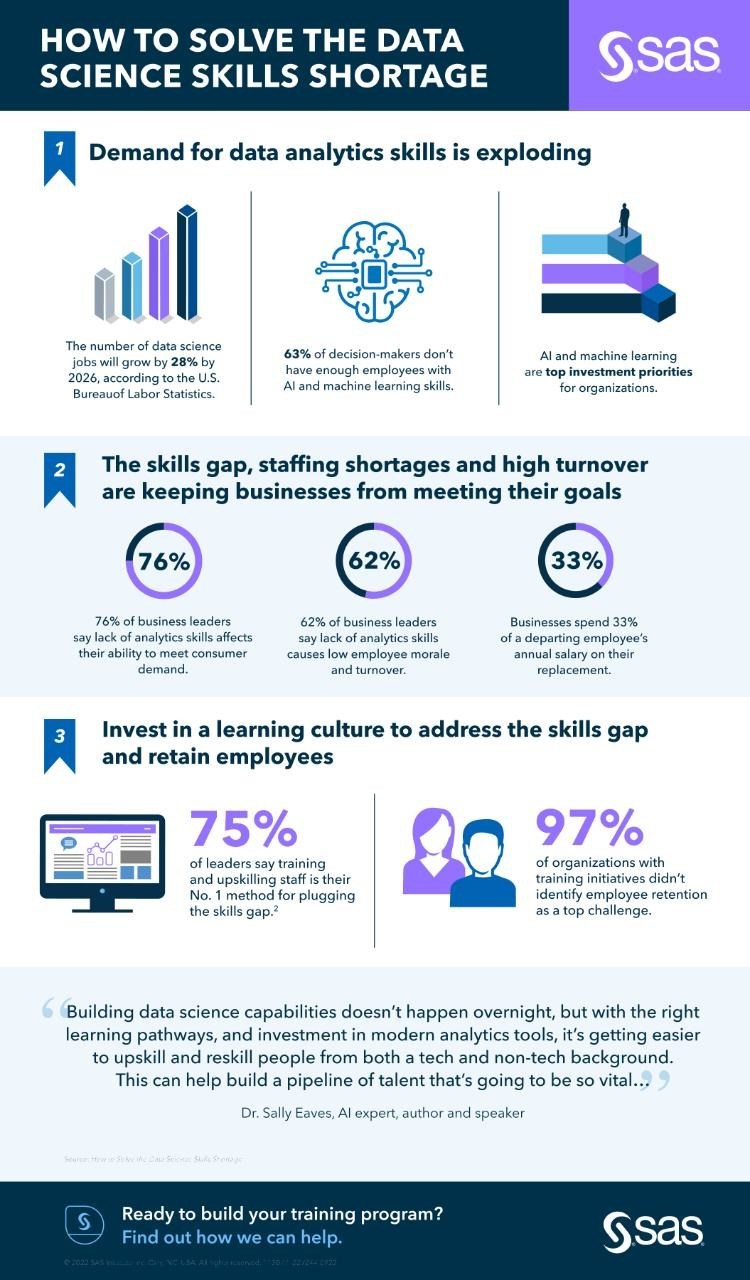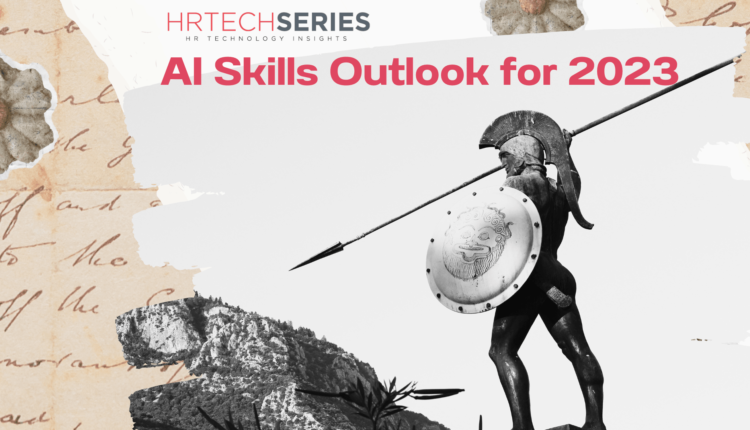Artificial intelligence is a great problem solver. However, it can also open a can of worms if AI requirements aren’t addressed fairly in an organization, especially when it comes to managing technology-related skill inventories. In the majority of discussions that we had with senior executives handling AI teams and research programs, we found out that finding, developing, and retaining a skilled AI workforce is the biggest priority for them right now. Alas! AI skills gaps are widening, and most employers have no answer to tackle this challenge.
Why so?
AI is impacting the way jobs are designed. New roles demand new kinds of skills and talent.
The skills gap has been a persistent problem faced by employers across all industries since the onset of the Industrial Revolution. As new technologies emerged, the working environment and the demand for skills also changed.
Traditionally, recruiters have always found themselves struggling to close the skills gaps during peak hiring seasons. In 2017, a survey reported that 67% of employers were concerned about the growing skills gaps and how these impact overall organizational productivity, revenue generation, and employee churn in the industry. Fast-forward to the year 2023, and the skills gaps have only widened due to the rapid innovations in the fields of artificial intelligence, cloud computing, IT security, and business analytics.
With AI adoption becoming mainstream in most companies, it is important to understand the skills gaps in this domain. Today, a majority of hiring managers face wider gaps in their workforce performance due to a lack of skilled professionals who can handle ongoing and upcoming AI and machine learning projects.
Skills gaps, if left unplugged for too long, could cost the company millions of dollars, in addition to a degraded company culture and depleted workforce resources.
As per Korn Ferry, US-based companies could be losing around $162 billion every year due to skill shortages in their industry. Organizations lose $4,129 for every job position that goes unfilled for 42 days—that’s just short of $100 per day. While it’s impossible to find a candidate who would meet all your requirements, it’s still an irony that organizations aren’t spending much on the upskilling of their existing employees!
In short, when a company is unable to fill vacant positions due to skill gaps, it could have a permanent impact on the way an organization operates in a challenging business environment.
The widening skills gaps could be attributed to these major reasons:
- A lack of formal educational structure in AI / STEM categories
- The rapid rate of retirement among the baby-boomers
- Misaligned training initiatives in hard versus soft skills development
- The pace of innovation in AI-led industries
Here are the biggest challenges that modern organizations face in addressing the existing employee skills inventory:
Lack of Awareness about Data Skills Gaps
Despite full commitment to AI projects, organizations have been lacking the in-house talent pool of skilled data engineers and AI developers who can execute the strategy. The in-house AI talent shortage continues to be the top barrier to taking AI projects to the finish line. In the current era of generative AI, the lack of data skills has only magnified the problems for recruiters in the US and the UK. In 2022, SAS reported that 63% of respondents claimed that their largest skills shortages were in the fields of AI and machine learning.
According to a survey by Corndell, 9 out of 10 senior data professionals stated that there is a skills gap in their organization. Senior leaders confessed to the lack of awareness among the employees regarding the data skills gaps.
Companies Lack Strong Data Leadership to Steer AI Roadmaps
Knowing is not leading.
Driving an AI change within an organization requires a strong foundation in leading skilled professionals in a competitive and agile environment. In a typical organization, more than two-thirds of the total workforce could be completely immune to data-driven activities. This glaring indifference in leadership about providing little or no access to data leads to incompetence in AI upskilling programs among the employees.
An average data-driven organization of 1000 employees would consist of a data team of 56 professionals, including three data stewards or chief officers. Then, there would be an additional number of shadow data professionals who could be utilizing data and analytics in their daily operations. Could all these team members be trained in data leadership, and expect them to increase data literacy through a culture of continuous learning, training, and development?
75% of business leaders cite that they would be out of the league if they couldn’t effectively scale their AI roadmap. “Ostrich” leaders are actually a big threat to the existing AI missions. With their heads deep beneath the ground, these leaders put off data culture transformation by ignoring data literacy and AI change management programs.
Organizations can see an actionable change in their AI-led teams only when the ML and analytics managers can establish data leadership with personal learning and upskilling goals. While employee training costs have definitely gone up, as have the investments that go into these programs, it is still unclear how much organizations are currently spending on developing AI skills at all levels of management.
To succeed in the current AI race, organizations should realign their foundational AI and data training programs toward middle-level managers.
Lacking an Overall Sense of Data Maturity
Data maturity is a key index in establishing an organization’s AI skills inventory infrastructure. Only 44% of data leaders cite that their existing data teams deliver meaningful value to the organization. Most organizations are fully aware of the need to scale their AI efforts to improve the effectiveness of their data and analytics teams. But how do you do it without building a pool of skilled workers?
That’s a question most leaders are still searching for answers to.
Corndel research has pointed out the need to achieve data maturity in the modern workplace through a nuanced integration of AI systems that function on data infrastructure and human expertise. These cover the potential threats looming in the industry, such as cyber security, data privacy, and compliance risks. 37% of data leaders cited the lack of data skills among employees as a barrier to business transformation. Another 47% of respondents cited human-related skills, while 45% said both AI and technical skills will hold back business transformation efforts in 2023.
Building a skilled AI workforce pool involves establishing the ground rules for promoting data maturity within the organization, and the industry, in general. It could include building skills in critical data management activities such as:
- data analysis
- data security
- data storage
- reporting and visualization
- data cleaning and re-engineering
- data ethics, and explainability
- AI literacy, and so on.
Psychological Safety, and Emotional Barriers
Recent investigations to find out AI’s impact on psychological safety in the workplace show remarkable results. For example, despite knowing that machines could potentially replace humans in their current roles, employees are less likely to voice their concerns to management.
And, then the irony strikes. When organizations strive to train employees in AI skills, employees themselves could be shrouded in self-doubt about the relevance of such an upskilling initiative!
“Will this AI training actually help me in my career growth?”
“What skills should I focus on?”
“If I enroll in an AI training program now, will this affect my ability to perform and deliver in my current role?”
“Do I need to upskill myself every time a new AI invention comes along?”
“What are the chances of me getting stereotyped into a monolithic AI system?”
“Would I have access to all the up-to-date AI and training resources now and in the future?”
“Can I choose my own AI upskilling program?” “Or, should I stick to what the organization offered?”
“Will the new upskilling program actually hamper my career movement to another organization in the future?”
Resistance to change and maintaining a status quo in the skills paradigm cost businesses more than economic downturns. Organizations thrive when they invest in humans and lead them in their career plans with technical expertise. The fear of failure and lack of focus put additional pressure on the AI upskilling initiatives. This is where self-awareness and leadership training play a pivotal role. These can address emotional barriers in AI skills development programs, helping organizations identify the factors that are influencing the emotional strengths and weaknesses of their employees.
Conclusion
From an employee’s point of view, the widening AI skills gaps could look entirely different than what they do for an employer or a hiring manager. 53% of employees have an optimistic outlook toward on-the-job AI upskilling training efforts initiated by their employers. Employers could enhance the impact of their skilled AI workforce development programs by creating better practical experience opportunities, promoting a life-long learning roadmap, and fostering industrial partnerships to nurture and retain a skilled AI workforce.
Overall, upskilling is not only cost-effective but also healthier from an overall managerial perspective.

While an AI-focused organization could have a clear roadmap for onboarding skilled AI professionals that enable AI projects, there could be latent skill gaps in the hierarchy. This could lead to a potential disparity between the employees and the AI management. An ambiguity in AI leadership and skills management can only be addressed through organizational restructuring and technological upskilling at the various levels of employability.
Moreover, employers must adopt an expansive hiring and training approach to tap into “overlooked” populations and meet AI needs with AI tools. While AI could erode 30% of existing jobs through automation, many new roles would also emerge by 2030. It is the responsibility of the data leaders to come out of their shells and actively lay the foundations for data maturity and AI upskilling initiatives in their current organizations.
So, what does your AI skill roadmap look like?
Please share your insights with us at sghosh@itechseries.com

